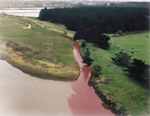Reasonable mixing: a challenge for planners
The Resource Management Act (sections 70 and 107) requires that any discharge to water authorised as a permitted activity or by a resource consent should not cause certain adverse effects after ‘reasonable mixing’. This concept creates challenges for planners writing regional water quality plans that protect environmental values and provide clear guidance for resource consent applicants.

Reasonable mixing acknowledges that it is sometimes necessary and acceptable to allow for a mixing zone – an area of the receiving water in which the water quality standards are not met. The question is: what size zone is reasonable?
A regional water plan cannot define a mixing zone that will be reasonable in all cases, because management objectives and environmental characteristics vary considerably between waterbodies. Justifiable definitions of reasonable mixing can really only be made on a case-by-case basis. ’...what is a reasonable mixing zone will be a question of fact and degree in each particular case...’ (Decision of Mahuta and Others v National Water and Soil Conservation Authority [NZTPA 73]). However, in a regional water plan, reserving discretion over what is ‘reasonable’ prevents that plan from providing any certainty either for resource users or environmental outcomes.
Councils that have prepared regional water quality plans have dealt with reasonable mixing in different ways. Some have elected to reserve discretion over the definition of reasonable mixing, and rely upon case-by-case consent decisions. Others have used rules-of-thumb such as 5 or 10 times a river’s channel width – which is pragmatic, but risks being overprotective or underprotective according to circumstances.
Other possible solutions have been explored and are discussed in the Surface Water Quality guidance note on the Quality Planning website (www.qualityplanning.org.nz). One approach matches different levels of discretion to specified maximum zones for different types of contaminants. The maximum zones would normally be acceptable in 90% of discharge cases. The aim is to provide plan users with certainty for permitted and prohibited activities, and helpful direction (while still retaining discretion over the final definition of reasonable mixing) for discretionary and non-complying activities.
For further discussion on this topic and implications for setting numeric water quality objectives and standards for rivers and lakes in regional plans, see www.qp.org.nz/uploads/best_practice/pubs/other/3928.pdf
Ned Norton [[email protected]] Elizabeth Eastmure, Ministry for the Environment [[email protected]] Raymond Ford, Environment Canterbury [[email protected]]
